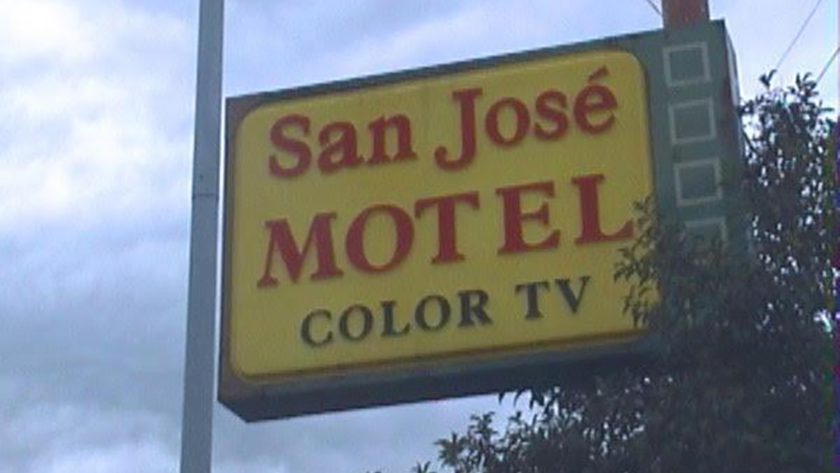In this review from South by Southwest 2021, editor Lydia De Matos examines the themes of gentrification at the core of an intimate documentary.
Framing is everything. Perhaps especially so in documentary. Even a story based in fact rather than fiction can be told an endless number of ways. A story handled thoughtfully by one filmmaker can be fumbled by another, turning a layered, honest work into something that leaves a bitter, offensive aftertaste. Now, all this probably seems more than self-evident, yet I find myself stating the obvious because Liz Lambert’s debut documentary Through the Plexi-Glass: The Last Days of the San José could have been brilliant, but its framing leaves the solid heart it is built upon sounding hollow.
Ninety percent of the film is a beautifully crafted documentary, constructed from what is essentially home video footage filmed by Lambert in the nineties, a period during which she owned and managed the San José Motel; a small, somewhat decrepit establishment in the neighbourhood of South Congress, Austin, Texas. Lambert quit her job as a lawyer to buy and run the motel, and the footage documents her day-to-day life: her attempts to fix up the place, failed loan applications for renovation, and – most crucially – her interactions with customers. Most of the people staying at the San José were living there full time, and so became a regular cast of characters in Lambert’s tapes. The footage feels intimate in a way that’s almost indescribable. The edit doesn’t rush anything; we are allowed to sit with the inhabitants of this little motel in South Congress, get to know their names – Diana and Gary Barrs, Gainey, Gerry van King, Henry Prince – their histories, their distinct mannerisms. This film may only contain snapshots of their lives, but after a point, it’s impossible not to feel as though you are well acquainted with the residents of the San José, as they existed at that point in time. As the film goes on, we begin to recognise the ways in which they have come to rely on each other and on Lambert, and the ways in which, whether or not she is aware of it, Lambert has also come to rely on them. Our placement within her camera means that we too begin to feel the connection she feels, to understand and feel a part of her newfound community; which is why it is all the more heartbreaking when that community begins to fall apart, not at the hands of some menacing outside force, but as a result of Lambert’s own actions.
From the very beginning of Through the Plexi-Glass, we are aware that Lambert’s original intention in buying the San José was to renovate it, to get a loan, close the hotel for a month, and turn the place into “a real hotel”. But loans are difficult to come by, especially if you’re the owner of a run-down motel situated in a part of Austin rarely frequented by tourists, and so the loan and the dreams of renovation begin to seem more like a pipe dream than an impending reality. But eventually, one of Lambert’s loan applications is granted, and as her plans begin to take shape it becomes clear that they do not involve the already existing community at the San José. She only plans to close for a month, but her conversations with the residents about their leaving do not mention their return when renovations are finished. It is an implicit understanding, never stated outright. This isn’t to call Lambert cold or callous, indeed one of the best things about the film is the subtle internal conflict we can see building, as the reality of what she’s doing closes in. Renovating the motel was her dream, but it feels as though it’s a dream she no longer wants, one she’s clinging onto solely because she once dreamt it. I feel compelled to shout at her through the screen, to tell her that she already has everything! She has everything because she was able to build a community of people she earnestly cares for, and who care for her too. But Liz Lambert has already renovated the San José. She did so over twenty years ago, and in doing so, triggered the gentrification of South Congress, Austin, Texas.

Back to the forefront comes the issue of framing. The final eight or so minutes of Through the Plexi-Glass bring us back to present day Austin, and the present day San José. Lambert explains how she wound up opening a number of hotels, forming a company called Bunkhouse, and later selling the majority of it to a larger company: Standard Hotels. Meanwhile, South Congress changed, it became more ‘hip’, a tourist destination and shopping district, the kind of place whose name is shortened to ‘SoCo’. After disagreements with Standard Hotels on how to run the company, Lambert was fired, and it is only after telling us this that she states she understands the irony of it all, the strangic karmic justice of being a cause of community displacement, and then herself being driven out. She says that she might have done things differently, but it feels cheap, too short a meditation, nowhere close enough to a reckoning, to real accountability. A Joan Didion quote flashes across the screen: “A place belongs forever to whoever claims it hardest, remembers it most obsessively, wrenches it from itself, shapes it, renders it, loves it so radically that he makes it in his own image,” and a part of me feels disgusted. South Congress belongs now to those able to afford the increased rent. The people who have shaped what it is today are those who bought out smaller businesses and attracted affluent customers looking for a sanitised version of what made the place intriguing to begin with. Was their remaking of the neighbourhood done out of radical love? Somehow, I doubt it.
There is a beautifully nuanced, heart-wrenching film to be found here. Despite what i’ve said, I thoroughly encourage you to watch it. The documentary that takes up the majority of Through the Plexi-Glass’ runtime is the work of a talented documentarian, and if it were to stand on its own, it would have been one of my favourite docs of the year. It is a shame, then, that ten minutes of framing have let it down.
Today, the San José is known as the Hotel San José. It’s the kind of hotel that self-describes as ‘boutique’, whose beds are made from something that resembles reclaimed wood, and whose rooms go for over three hundred dollars a night. It throws musical events and is one of the locations hosting Austin’s South by Southwest festival each year. Its website declares it ‘a South Congress gathering place for locals and visitors alike’, and maybe that’s true now, but I can’t help but think of Diana and Gary Barrs, of Gainey, of Gerry van King, of Henry Prince; of the people who called the San José home twenty-five years ago, and whether or not they can afford to be ‘locals’ now, or if the community displacement caused by gentrification – an issue that this documentary holds at its very core, perhaps more than anything else – has reduced them to visitors in their own home town.




